Intel NUC 13 Pro Arena Canyon Review: Raptor Lake Brings Incremental Gains
by Ganesh T S on March 27, 2023 9:00 AM ESTSystem Performance: Miscellaneous Workloads
Standardized benchmarks such as UL's PCMark 10 and BAPCo's SYSmark take a holistic view of the system and process a wide range of workloads to arrive at a single score. Some systems are required to excel at specific tasks - so it is often helpful to see how a computer performs in specific scenarios such as rendering, transcoding, JavaScript execution (web browsing), etc. This section presents focused benchmark numbers for specific application scenarios.
3D Rendering - CINEBENCH R23
We use CINEBENCH R23 for 3D rendering evaluation. R23 provides two benchmark modes - single threaded and multi-threaded. Evaluation of different PC configurations in both supported modes provided us the following results.
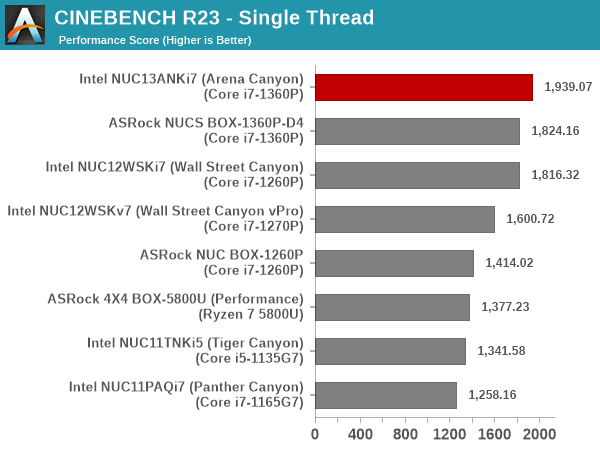
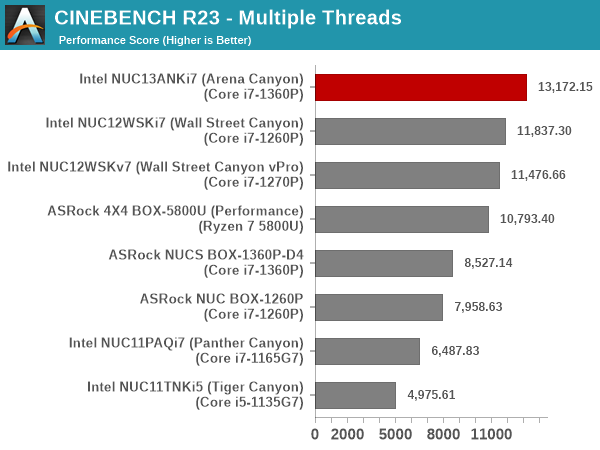
The single-thread performance for the Arena Canyon NUC and the NUCS BOX-1360P/D4 round out the top two spots, but the NUCS BOX loses out significantly in the multi-threaded case due to the lower power budget (PL1 of 28W, compared to 40W for the NUC 13 Pro).
Transcoding: Handbrake 1.5.1
Handbrake is one of the most user-friendly open source transcoding front-ends in the market. It allows users to opt for either software-based higher quality processing or hardware-based fast processing in their transcoding jobs. Our new test suite uses the 'Tears of Steel' 4K AVC video as input and transcodes it with a quality setting of 19 to create a 720p AVC stream and a 1080p HEVC stream.


Software transcoding performance is dependent on the available power budget and number of cores. The Arena Canyon NUC is on top in both of these aspects, and it is not a surprise to see it march well ahead of the competition.
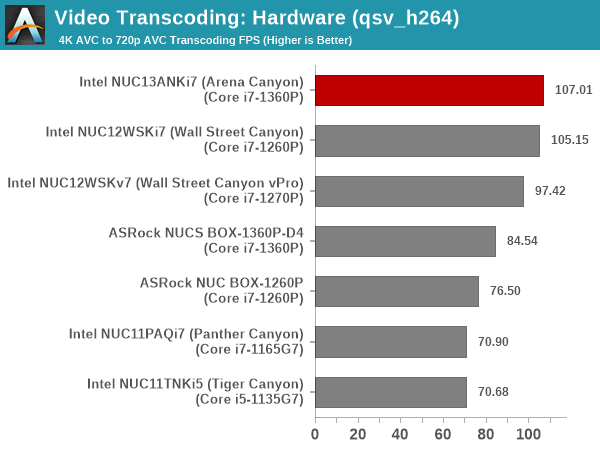
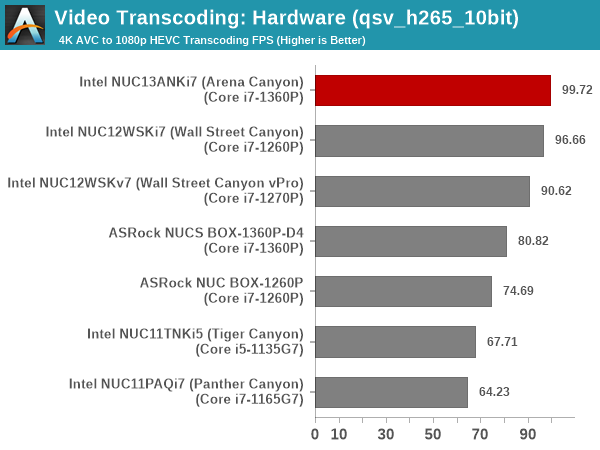
Hardware transcoding performance is dependent on the iGPU clock speeds and Raptor Lake-P is the best equipped family on that front. The extra power budget over the ASRock Industrial configuration helps the Arena Canyon NUC come out on top.
Archiving: 7-Zip 21.7
The 7-Zip benchmark is carried over from our previous test suite with an update to the latest version of the open source compression / decompression software.
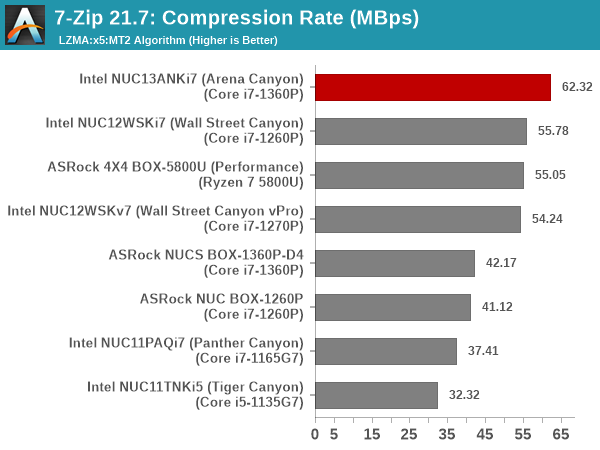
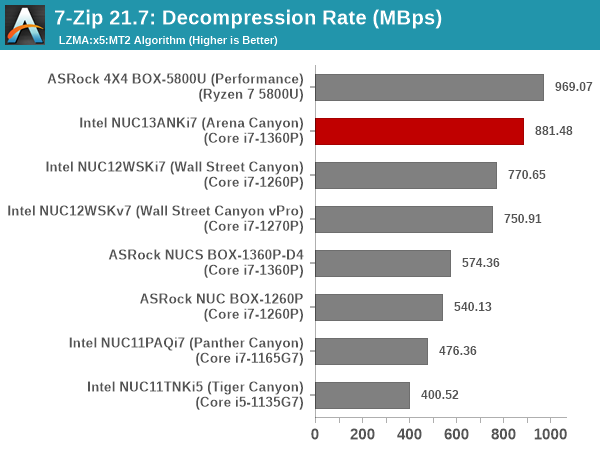
The power budget and number of cores helps the Arena Canyon NUC take the top spot in the compression component, but the Ryzen 7-5800U has enough chops to take the crown in the decompression test. Within the Intel family, the RPL-P implementation from Intel is the undisputed leader in both components.
Web Browsing: JetStream, Speedometer, and Principled Technologies WebXPRT4
Web browser-based workloads have emerged as a major component of the typical home and business PC usage scenarios. For headless systems, many applications based on JavaScript are becoming relevant too. In order to evaluate systems for their JavaScript execution efficiency, we are carrying over the browser-focused benchmarks from the WebKit developers used in our notebook reviews. Hosted at BrowserBench, JetStream 2.0 benchmarks JavaScript and WebAssembly performance, while Speedometer measures web application responsiveness.
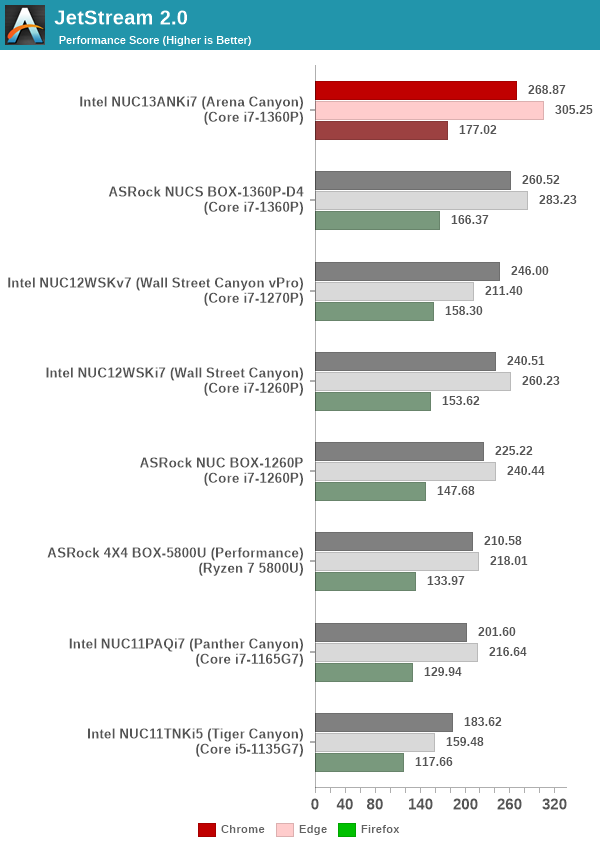

From a real-life workload perspective, we also process WebXPRT4 from Principled Technologies. WebXPRT4 benchmarks the performance of some popular JavaScript libraries that are widely used in websites.
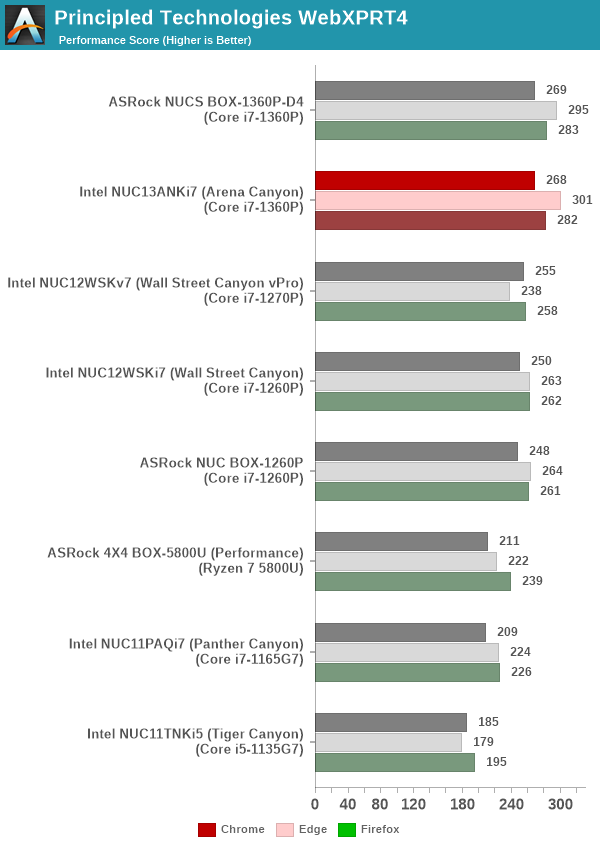
In sustained benchmarking (like in Jetstream and Speedometer), the PL1 and PL2 values influence the results allowing the Arena Canyon NUC to take the top spot. However, in the more realistic use-case with webXPRT4, the NUC 13 Pro and the ASRock Industrial NUCS BOX-1360P/D4 perform very similar to each other across different browsers.
Application Startup: GIMP 2.10.30
A new addition to our systems test suite is AppTimer - a benchmark that loads up a program and determines how long it takes for it to accept user inputs. We use GIMP 2.10.30 with a 50MB multi-layered xcf file as input. What we test here is the first run as well as the cached run - normally on the first time a user loads the GIMP package from a fresh install, the system has to configure a few dozen files that remain optimized on subsequent opening. For our test we delete those configured optimized files in order to force a fresh load every second time the software is run.
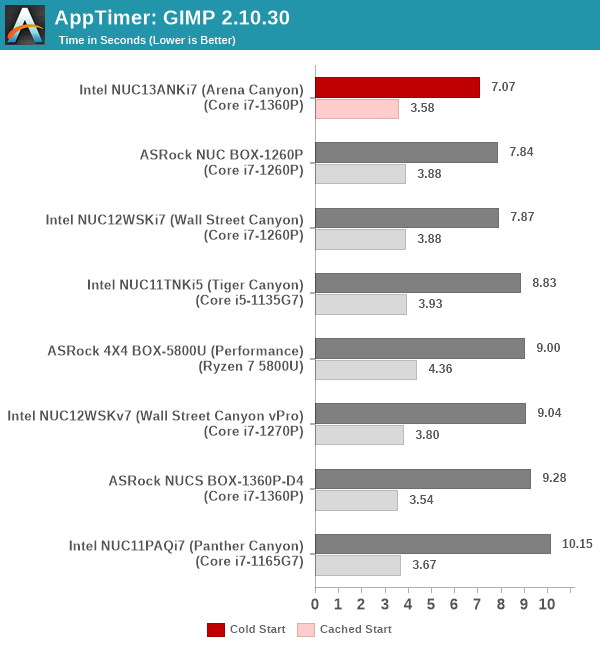
As it turns out, GIMP does optimizations for every CPU thread in the system, which requires that higher thread-count processors take a lot longer to run. So the test runs quick on systems with fewer threads, however fast cores are also needed. The cached start numbers for the ASRock Industrial system and the Arena Canyon NUC are similar, but the latter is significantly better in the cold start scenario.
Cryptography Benchmarks
Cryptography has become an indispensable part of our interaction with computing systems. Almost all modern systems have some sort of hardware-acceleration for making cryptographic operations faster and more power efficient. In the case of business use-cases, many applications such as VPN need cryptography acceleration.
BitLocker is a Windows features that encrypts entire disk volumes. While drives that offer encryption capabilities are dealt with using that feature, most legacy systems and external drives have to use the host system implementation. Windows has no direct benchmark for BitLocker. However, we cooked up a BitLocker operation sequence to determine the adeptness of the system at handling BitLocker operations. We start off with a 4.5GB RAM drive in which a 4GB VHD (virtual hard disk) is created. This VHD is then mounted, and BitLocker is enabled on the volume. Once the BitLocker encryption process gets done, BitLocker is disabled. This triggers a decryption process. The times taken to complete the encryption and decryption are recorded. This process is repeated 25 times, and the average of the last 20 iterations is graphed below.
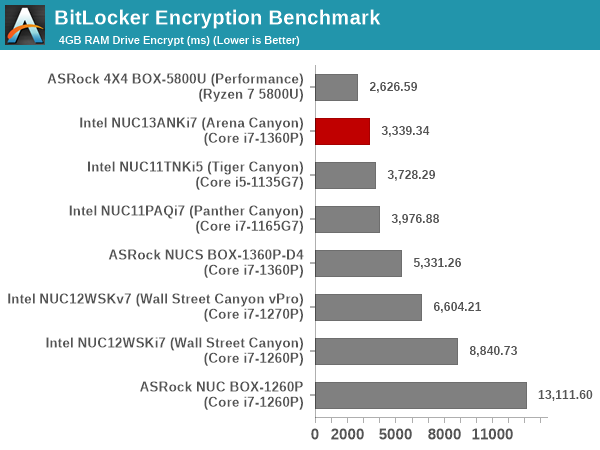
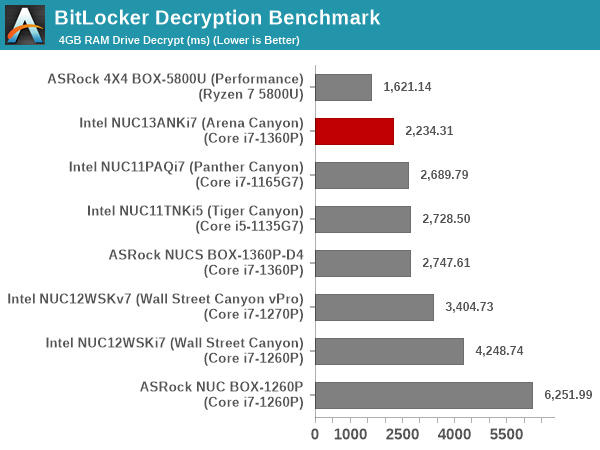
Hardware acceleration is available for the operations in all of the systems. The time taken for processing is directly dependent on the available power budget. Faster acceleration with more number of stronger cores in the Ryzen 7-5800U help the 4x4 BOX-5800U perform significantly better than the rest of the systems in this benchmark. The Arena Canyon NUC turns out to be the best of the Intel lot, as one would expect from the latest generation.










46 Comments
View All Comments
PeachNCream - Tuesday, March 28, 2023 - link
I congratulate you. Your bait caught a lot of them this time. And, like a true troll, you didn't waste keystrokes doing it. Though, admittedly, computer enthusiasts are low hanging fruit that get riled up with minimal work.MrCommunistGen - Monday, March 27, 2023 - link
I'm pretty pleased that there are P-series chips and not just U-series - as many (but not all) previous SFF NUCs used 15W TDP chips rather than 28W and higher TDP mobile CPUs. As long as the cooler can handle the heat load and isn't too terribly loud (or can have its performance/fan curves adjusted) then this could be a really cool SFF PC.I currently have a NUC8i7BEH i7-8559U (28W 4c/8t + eDRAM) which I'm not YET looking to upgrade, but this new 13th Gen NUC is the first model that's gotten me excited about a new NUC in this form factor.
Samus - Tuesday, March 28, 2023 - link
I agree. The P-series was a solid move on Intel's part to stay competitive against Ryzen mobile parts. Even though most notebooks don't seem to utilize the TDP Up (if its a thin plastic laptop kiss PL2 goodbye entirely) the single-threaded boost performance is above U-series parts, and general workflow at low-loads benefit from the stronger E-core headroom. Intel competitively prices the P chips against the U chips as well, which is why you see them in cheaper laptops.abufrejoval - Tuesday, March 28, 2023 - link
The latest U-series to me represent an attempt to have at least a toenail in a fully passive market and that's not an economy niche, even if Intel can put more of them on a wafer: sometimes Intel is strangely insensitive to wasting die area!And since NUCs have always used active cooling even for their Atom models, U-series SoCs simply have no business there.
I am also a fan of the great NUC fan curves, because they allow you to achieve unobtrusiveness, which is only beaten by "never need cleaning out fans and grills", but not at the price of crippled performance or an Akasa case.
I have the same NUC and it's younger cousins, a hexacore NUC10 and a Tiger Lake NUC11. And that last "custom Apple" SoC with the Iris 655 iGPU in the i7-8559U spends more than half its die area on an iGPU that Intel never charged for, but mostly because it didn't actually pay of in performance.
The Tiger Lake trounces NUC8 and 10 by 25% on scalar peformance while the 6 cores of Gen10 and 4 cores of Gen11 draw even on multicore.
The Tiger Lake's 96EU Xe iGPU puts the Iris 48EU iGPU to shame, which only gets 50% performance increase over an 24EU iGPU from the NUC10 for twice the EUs and without needing the eDRAM, which doesn't help nearly as much as it must have cost in production. It marks the turning point for Apple, which wanted much more GPU power at mobile power budgets.
Yes, you can expect a tempting performance uplift from one of these, should you make the switch. But a gaming engine it won't be, because 4x the speed of a lame duck is still pretty lame.
ekon - Monday, March 27, 2023 - link
I like the multitasking benchmarks; don't see that attempted very often as it's not an off-the-shelf test and involves the time and risk of coming up with your own methodology, but it's teased out some interesting results.cruiseliu - Monday, March 27, 2023 - link
Kinda surprised it's still DDR4.Samus - Tuesday, March 28, 2023 - link
I was surprised to see that too. Even 6 months ago I wouldn't be since DDR5 SODIMMs were still elusive unicorns but nowadays they are plentiful and price competitive with DDR4. I've seen 32GB 16x2 kits of Crucial DDR5 5200(?) SODIMMs from B&H for $100 shipped yet nothing mobile seems to take DDR5, and if it does, it's non-upgradable (looking at you XPS 13)Fenturi - Tuesday, March 28, 2023 - link
U690 6800hx based with swappable ddr5MrCommunistGen - Tuesday, March 28, 2023 - link
Me too. I was going to write a follow-up comment about that, but then got a bit derailed writing my anti-rant comment.I suspect that the re-use of DDR4 was a cost saving measure so that they could (mostly) re-use the memory traces, etc from previous NUC boards instead of having to rework that for DDR5.
DDR5 doesn't help all workloads, particularly at JEDEC speeds, but there's definitely some where it helps. Having that little bit of extra performance in this form factor would be appreciated.
Einy0 - Tuesday, March 28, 2023 - link
In response to all the Mac mini comments. I've wanted to dip my toe into the OSX pond for a while now. I do some moonlighting for a business that uses a lot of Macs, and I feel like more hands on time with a Mac would be useful. The ancient Macbook own gives me some exposure but a lot was changed since OSX 10.6.8 . I just can't bring myself to get a mini with only 8GB or RAM. My Macbook has 4GB and a decent SSD and it is SLOW! I imagine newer versions of OSX are more memory hungry, like everything else. I also WILL NOT pay $200 more for $25 worth of RAM. It is plain insulting! Shame on Apple...